Structural Improvements in Consensus-Based Cooperative Control of DC Microgrids
Abstract
:1. Introduction
1.1. Motivation
1.2. Literature Review
1.3. Contributions
- Finite-gain voltage controller is introduced in the outer voltage loop with a simple proportional (P) controller in the inner current control loop. In this way, droop-like performance can be ensured without droop control.
- A different method is adopted in the consensus-based cooperative control to estimate the average voltage and current difference. Proportional current sharing and DC voltage restoration can be guaranteed by updating the single voltage correction term of the consensus control layer.
- The proposed control technique does not require prior knowledge of the nodes, so the proposed technique is scalable and has plug-and-play capability.
- A sparse communication network spans across the DC microgrid, due to which neighbors can interact with each other. This is different from the centralized technique.
- In order to ensure a good bandwidth and better control performance, the impact of communication delay is considered and analyzed. The voltage control loop bandwidth is also considered with the increasing number of nodes.
- In the presence of disturbance, the convergence time (disturbance rejection time) of the proposed controller is compared with the conventional power-sharing techniques.
2. Overview of Existing Techniques
2.1. Conventional Droop-Control-Based Technique
2.1.1. Local Controller
2.1.2. Cooperative Controller
2.2. Conventional Droop-less Technique
Local Controller
2.3. Limitations of the Existing Techniques
3. Proposed Technique
3.1. Proposed Local Controller
3.2. Cooperative Control Structure
4. Small Signal Analysis
5. Communication Network Overview and Graph Theory
Communication Delay Impact on System Performance
6. Simulation Results and Discussion
7. Conclusions
Author Contributions
Funding
Conflicts of Interest
References
- Bevrani, H.; Francois, B.; Ise, T. Microgrid Dynamics and Control; John Wiley & Sons: Hoboken, NJ, USA, 2017. [Google Scholar]
- Pogaku, N.; Prodanovic, M.; Green, T.C. Modeling, Analysis and Testing of Autonomous Operation of an Inverter-Based Microgrid. IEEE Trans. Power Electron. 2007, 22, 613–625. [Google Scholar] [CrossRef]
- Li, Y.W.; Kao, C.-N. An Accurate Power Control Strategy for Power-Electronics-Interfaced Distributed Generation Units Operating in a Low-Voltage Multibus Microgrid. IEEE Trans. Power Electron. 2009, 24, 2977–2988. [Google Scholar]
- Kaundinya, D.P.; Balachandra, P.; Ravindranath, N.H. Grid-Connected Versus Stand-alone Energy System decentralized Power-A Review of Literature. Renew. Sustain. Energy Rev. 2009, 13, 2041–2050. [Google Scholar] [CrossRef]
- Xu, L.; Chen, D. Control and operation of a DC microgrid with variable generation and energy storage. IEEE Trans. Power Deliv. 2011, 26, 2513–2522. [Google Scholar] [CrossRef]
- Kakigano, H.; Miura, Y.; Ise, T. Distribution voltage control for DC microgrids using fuzzy control and gain-scheduling technique. IEEE Trans. Power Electron. 2013, 28, 2246–2258. [Google Scholar] [CrossRef]
- Jiang, Z.; Yu, X. Hybrid DC- and AC-linked microgrids: Towards integration of distributed energy resources. In Proceedings of the 2008 IEEE Energy 2030 Conference, Atlanta, GA, USA, 17–18 November 2008; pp. 1–8. [Google Scholar]
- Chen, Y.K.; Wu, Y.C.; Song, C.C.; Chen, Y.S. Design and implementation of energy management system with fuzzy control for DC microgrid systems. IEEE Trans. Power Electron. 2013, 28, 1563–1570. [Google Scholar] [CrossRef]
- Chakraborty, P.; Baeyens, E.; Khargonekar, P.P. Distributed control of flexible demand using proportional allocation mechanism in a smart grid: Game theoretic interaction and price of anarchy. Sustain. Energy Grids Netw. 2017, 12, 30–39. [Google Scholar] [CrossRef]
- Anand, S.; Fernandes, B.G.; Guerrero, J.M. Distributed control to ensure proportional load sharing and improve voltage regulation in low-voltage DC microgrids. IEEE Trans. Power Electron. 2013, 28, 1900–1913. [Google Scholar] [CrossRef]
- Nasirian, V.; Member, S.; Moayedi, S.; Member, S.; Davoudi, A.; Lewis, F.L. Distributed Cooperative Control of DC Microgrids. IEEE Trans. Power Electron. 2015, 30, 2288–2303. [Google Scholar] [CrossRef]
- Lu, X.; Guerrero, J.M.; Sun, K.; Vasquez, J.C. An improved droop control method for dc microgrids based on low bandwidth communication with dc bus voltage restoration and enhanced current sharing accuracy. IEEE Trans. Power Electron. 2014, 29, 1800–1812. [Google Scholar] [CrossRef]
- Yang, Y.; Khan, M.M.; Yu, J. An improved cooperative control method of DC microgrid based on nearest neighbors communication. In Proceedings of the IECON 2017—43rd Annual Conference of the IEEE Industrial Electronics Society, Beijing, China, 29 October–1 November 2017; pp. 792–797. [Google Scholar]
- Pecas Lopes, J.A.; Moreira, C.L.; Madureira, A.G. Defining control strategies for analysing microgrids islanded operation. In Proceedings of the 2005 IEEE Russia Power Tech, St. Petersburg, Russia, 27–30 June 2005; pp. 1–7. [Google Scholar]
- Di Fazio, A.R.; Russo, M.; De Santis, M. Zoning Evaluation for Voltage Optimization in Distribution Networks with Distributed Energy Resources. Energies 2019, 12, 390. [Google Scholar] [CrossRef]
- Li, C.; Yu, X.; Yu, W.; Huang, T.; Liu, Z.-W. Distributed event-triggered scheme for economic dispatch in smart grids. IEEE Trans. Ind. Informat. 2016, 12, 1775–1785. [Google Scholar] [CrossRef]
- Ding, L.; Han, Q.L.; Guo, G. Network-based leader-following consensus for distributed multi-agent systems. Automatica 2013, 49, 2281–2286. [Google Scholar] [CrossRef]
- Kounev, V.; Tipper, D.; Grainger, B.M.; Reed, G. Analysis of an offshore medium voltage DC microgrid environment—Part II: Communication network architecture. In Proceedings of the 2014 IEEE PES T&D Conference and Exposition, Chicago, IL, USA, 14–17 April 2014; pp. 1–5. [Google Scholar]
- Qiu, W.; Liang, Z. Practical design considerations of current sharing control for parallel VRM applications. In Proceedings of the Twentieth Annual IEEE Applied Power Electronics Conference and Exposition, APEC 2005, Austin, TX, USA, 6–10 March 2005; Volume 1, pp. 281–286. [Google Scholar]
- Ferreira, R.A.F.; Braga, H.A.C.; Ferreira, A.A.; Barbosa, P.G. Analysis of voltage droop control method for dc microgrids with Simulink: Modelling and simulation. In Proceedings of the 2012 10th IEEE/IAS International Conference on Industry Applications, Fortaleza, Brazil, 5–7 November 2012. [Google Scholar] [CrossRef]
- Lu, X.; Sun, K.; Guerrero, J.M.; Vasquez, J.C.; Huang, L. State-of-charge balance using adaptive droop control for distributed energy storage systems in DC microgrid applications. IEEE Trans. Ind. Electron. 2014, 61, 2804–2815. [Google Scholar] [CrossRef]
- Guerrero, J.M.; Vasquez, J.C.; Matas, J.; de Vicuna, L.G.; Castilla, M. Hierarchical Control of Droop-Controlled AC and DC Microgrids—A General Approach toward Standardization. IEEE Trans. Ind. Electron. 2011, 58, 158–172. [Google Scholar] [CrossRef]
- Anand, S.; Fernandes, B. Steady state performance analysis for load sharing in DC distributed generation system. In Proceedings of the 2011 10th International Conference on Environment and Electrical Engineering, Rome, Italy, 8–11 May 2011; pp. 1–4. [Google Scholar]
- He, J.; Li, Y.W. Analysis, design, and implementation of virtual impedance for power electronics interfaced distributed generation. IEEE Trans. Ind. Appl. 2011, 47, 2525–2538. [Google Scholar] [CrossRef]
- Zhong, Q.C. Robust droop controller for accurate proportional load sharing among inverters operated in parallel. IEEE Trans. Ind. Electron. 2013, 60, 1281–1290. [Google Scholar] [CrossRef]
- Khorsandi, A.; Ashourloo, M.; Mokhtari, H. A Decentralized Control Method for a Low-Voltage DC Microgrid. IEEE Trans. Energy Convers. 2014, 29, 793–801. [Google Scholar] [CrossRef]
- Mohammed, Y.A.I.; El-Saadany, E.F. Adaptive Decentralized Droop Controller to Preserve Power Sharing Stability of Paralleled Inverters in Distributed Generation Microgrids. IEEE Trans. Power Electron. 2008, 23, 2806–2816. [Google Scholar] [CrossRef]
- Zhang, C.K.; Jiang, L.; Wu, Q.H.; He, Y.; Wu, M. Delay-dependent robust load frequency control for time delay power systems. IEEE Trans. Power Syst. 2013, 28, 2192–2201. [Google Scholar] [CrossRef]
- Liu, S.; Wang, X.; Liu, P.X. Impact of Communication Delays on Secondary Frequency Control in an Islanded Microgrid. IEEE Trans. Ind. Electron. 2015, 62, 2021–2031. [Google Scholar] [CrossRef]
- Hu, T.; Khan, M.M.; Xu, K.; Zhou, L.; Rana, A. Design of an input-parallel output-parallel multi-module dc-dc converter using a ring communication structure. J. Power Electron. 2015, 15, 886–898. [Google Scholar] [CrossRef]
- Saber, R.O.; Murray, R.M. Consensus Problems in Networks of Agents with Switching Topology and Time-Delays. IEEE Trans. Autom. Control 2003, 49, 1520–1533. [Google Scholar] [CrossRef]
- Wu, X.; Shen, C.; Iravani, R. A Distributed, Cooperative Frequency and Voltage Control for Microgrids. IEEE Trans. Smart Grid 2018, 9, 2764–2776. [Google Scholar] [CrossRef]
- Zhang, Y.; Xie, L.; Ding, Q. Interactive Control of Coupled Microgrids for Guaranteed System-Wide Small Signal Stability. IEEE Trans. Smart Grid 2016, 7, 1088–1096. [Google Scholar] [CrossRef]
- Arefifar, S.A.; Mohamed, Y.A.R.I.; El-Fouly, T. Optimized multiple microgrid-based clustering of active distribution systems considering communication and control requirements. IEEE Trans. Ind. Electron. 2015, 62, 711–723. [Google Scholar] [CrossRef]
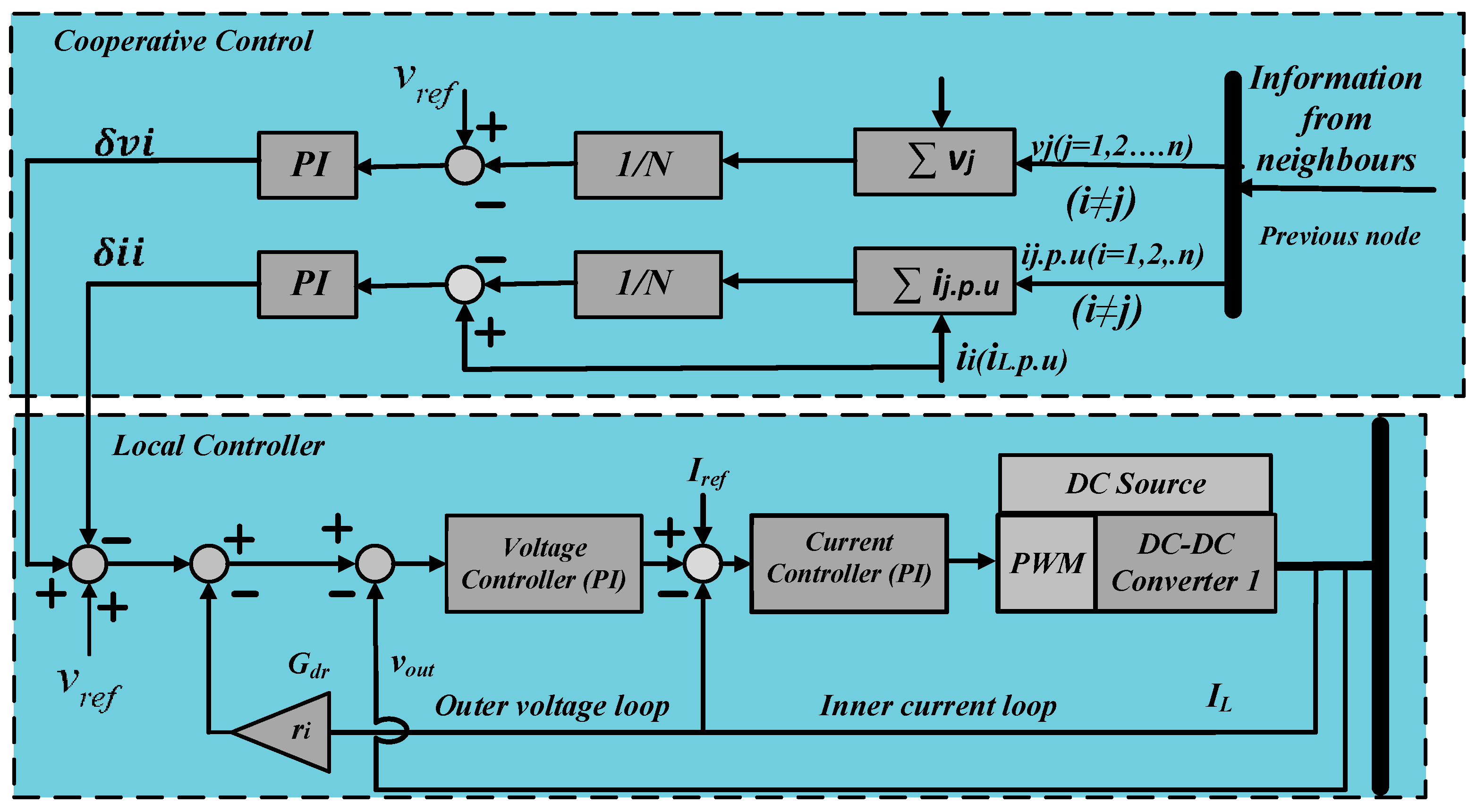





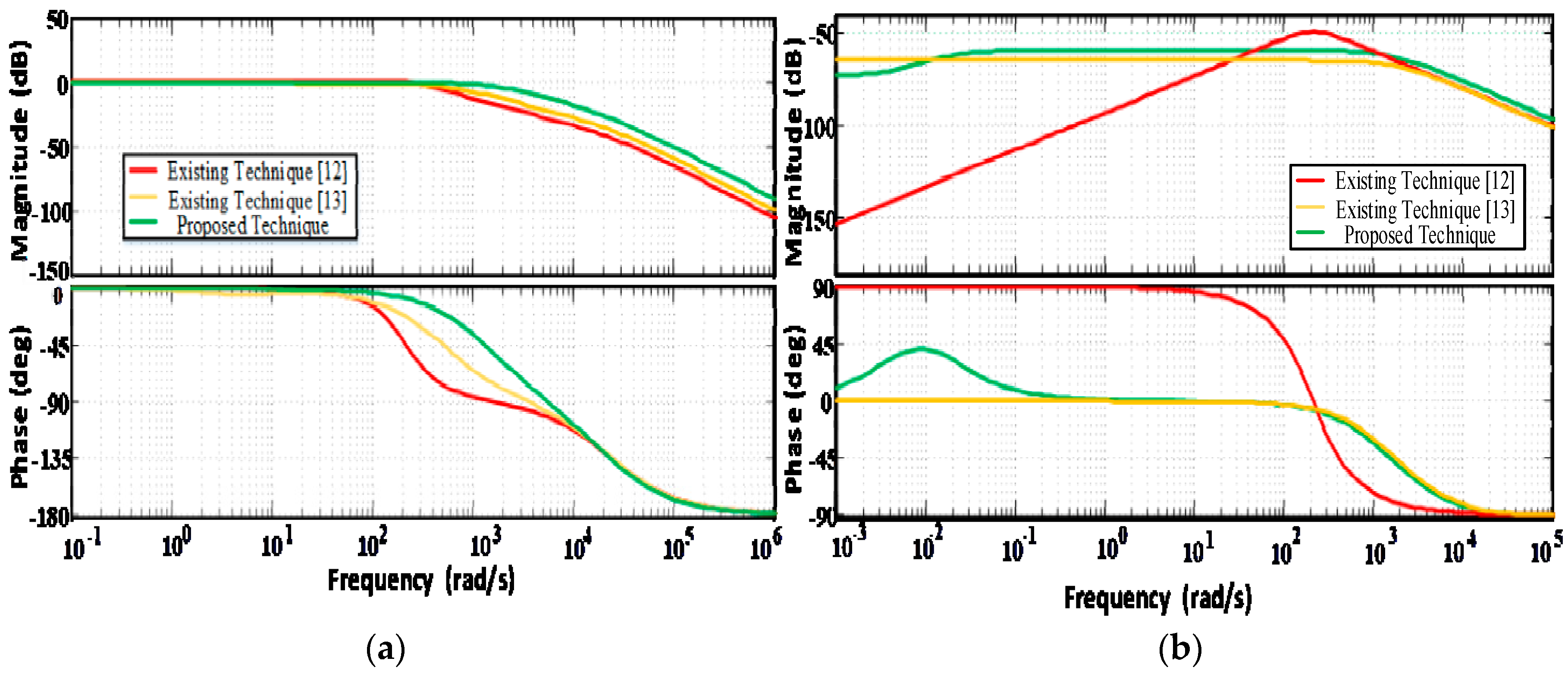


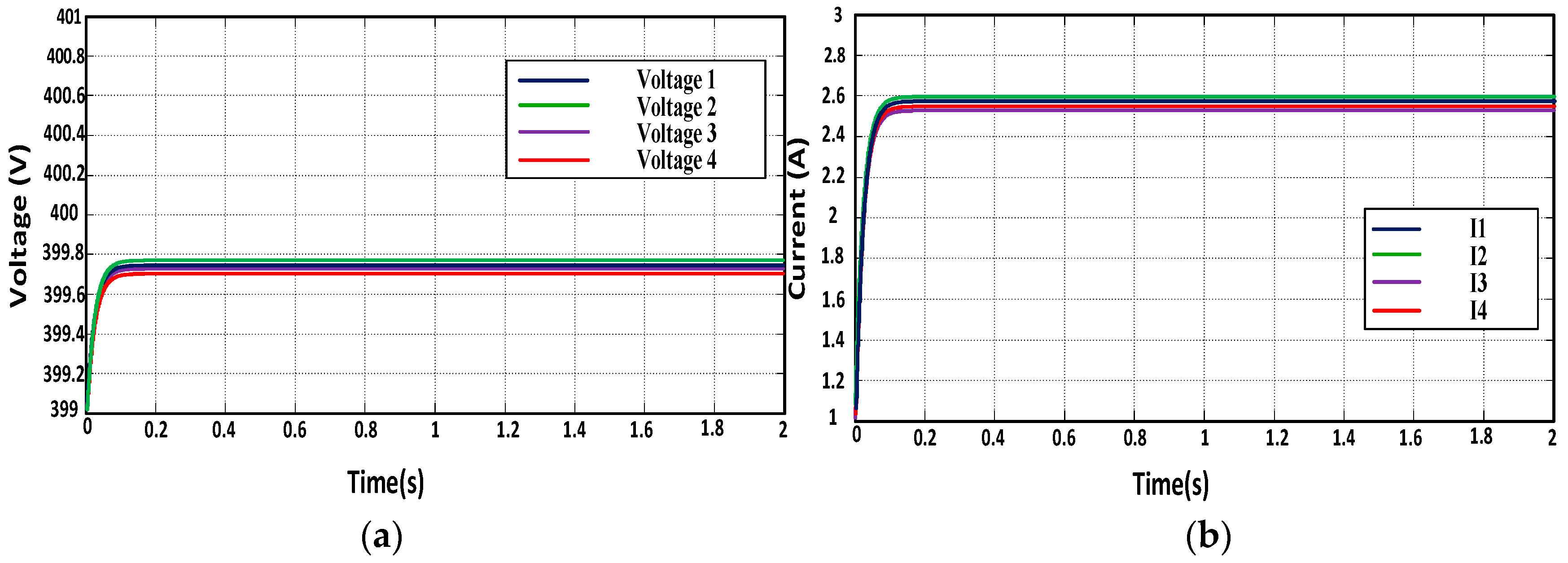
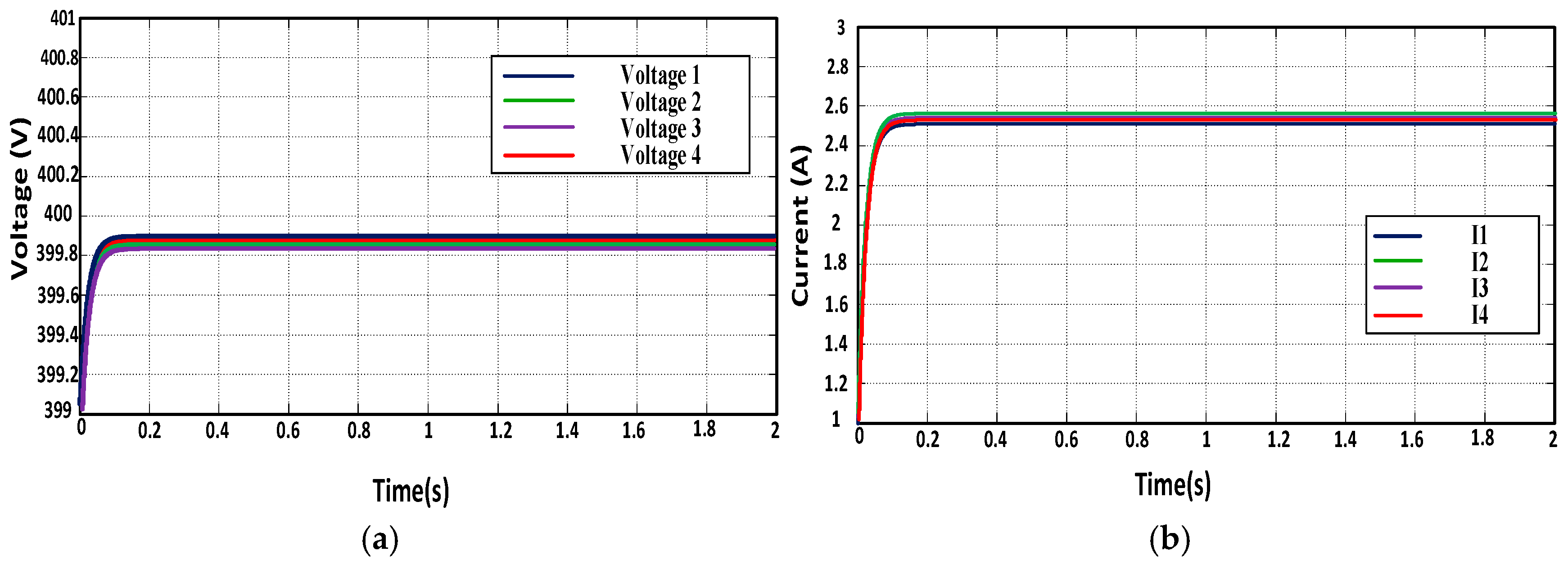


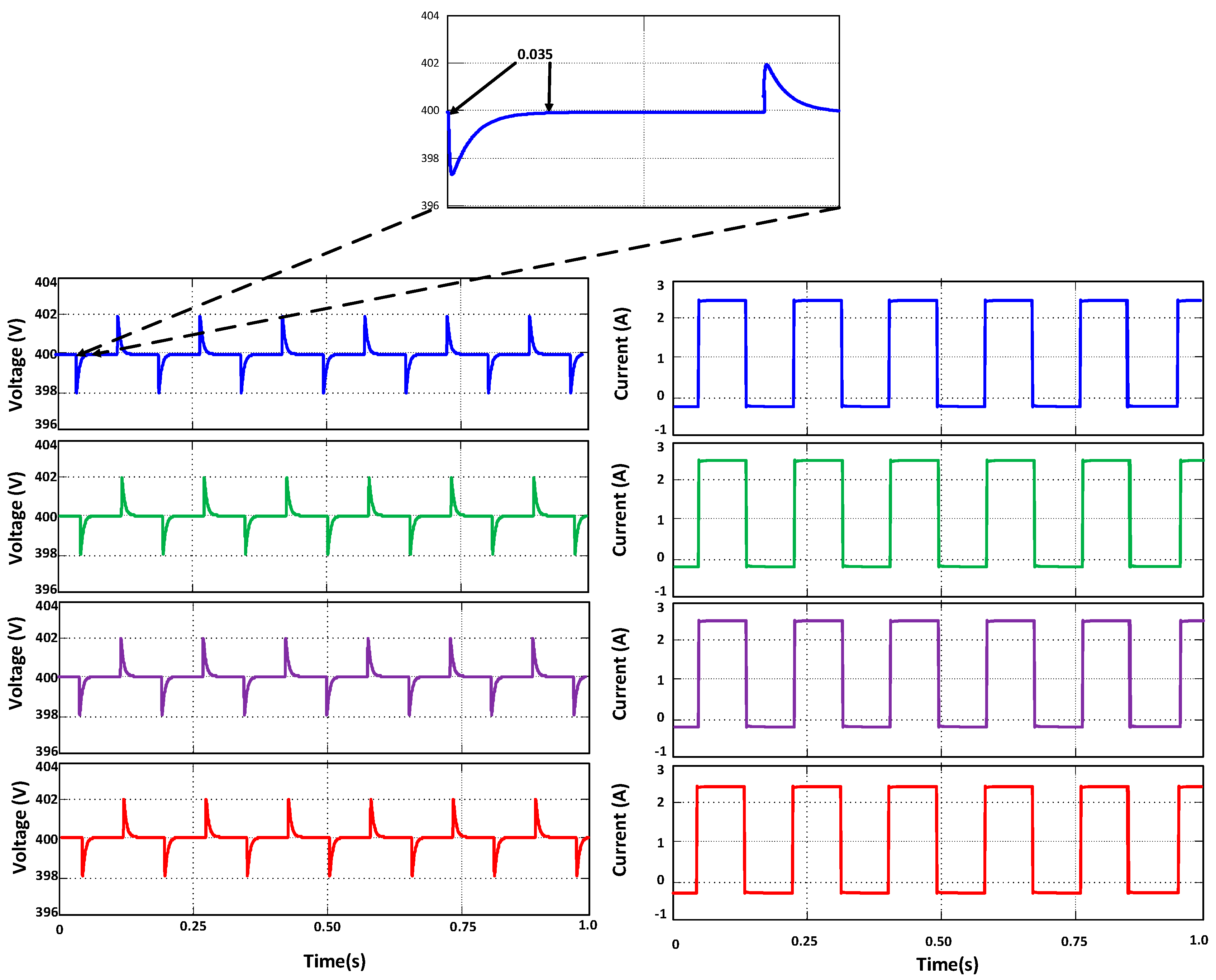
| Power-Sharing Techniques | Stability | Disturbance Rejection Time | Current-Sharing Accuracy | Voltage Regulation | Viability |
|---|---|---|---|---|---|
| Conventional droop-based technique [12] | Low | High | High | High | Low |
| Improved cooperative control technique [13] | Medium | Medium | High | Medium | Medium |
| Proposed technique | High | Low | High | High | High |
| Communication Delay | Existing Technique [12], Voltage Control Bandwidth | Existing Technique [13], Voltage Control Bandwidth | Proposed Technique, Voltage Control Bandwidth |
|---|---|---|---|
| 0.1 ms | 0.507 kHz | 0.528 kHz | 0.550 kHz |
| 0.05 ms | 0.520 kHz | 0.540 kHz | 0.562 kHz |
| 0.33 ms | 0.525 kHz | 0.546 kHz | 0.568 kHz |
| 0.40 ms | 0.528 kHz | 0.548 kHz | 0.570 kHz |
| Number of nodes | Bandwidth with increasing nodes | Bandwidth with increasing nodes | Bandwidth with increasing nodes |
| 5 | 0.520 kHz | 0.540 kHz | 0.562 kHz |
| 10 | 0.270 kHz | 0.295 kHz | 0.320 kHz |
| 20 | 0.145 Hz | 0.170 kHz | 0.205 kHz |
| Parameters | Existing Technique [12] | Existing Technique [13] | Proposed Technique | |
|---|---|---|---|---|
| PV/Wind | Vg | 600 V | 600 V | 600 V |
| Reference voltage | Vref | 400 V | 400 V | 400 V |
| DC/DC Buck converter | L | 2.5 mH | 2.5 mH | 2.5 mH |
| C | 220 μF | 220 μF | 220 μF | |
| Inner loop | kp | 0.1 | 0.1 | 0.09 |
| ks | 0.5 | 0.5 | — | |
| Outer loop | kp | 0.05 | 0.2 | — |
| ks | 10 | — | — | |
| z | — | — | 0.045 | |
| p | — | — | 0.0045 | |
| Droop gain | Gd | 0.025 | — | — |
| Distributed cooperative control | kpc,v | 1.7 | 10 | 25 |
| ksc,v | 15 | 200 | 150 | |
| kpc,i | 1.5 | — | — | |
| ksc,i | 2.5 | — | — |
© 2019 by the authors. Licensee MDPI, Basel, Switzerland. This article is an open access article distributed under the terms and conditions of the Creative Commons Attribution (CC BY) license (http://creativecommons.org/licenses/by/4.0/).
Share and Cite
Mumtaz, M.A.; Khan, M.M.; Fang, X.; Shahid, M.U.; Faiz, M.T. Structural Improvements in Consensus-Based Cooperative Control of DC Microgrids. Electronics 2019, 8, 187. https://doi.org/10.3390/electronics8020187
Mumtaz MA, Khan MM, Fang X, Shahid MU, Faiz MT. Structural Improvements in Consensus-Based Cooperative Control of DC Microgrids. Electronics. 2019; 8(2):187. https://doi.org/10.3390/electronics8020187
Chicago/Turabian StyleMumtaz, Muhammad Adnan, Muhammad Mansoor Khan, Xiangzhong Fang, Muhammad Umair Shahid, and Muhammad Talib Faiz. 2019. "Structural Improvements in Consensus-Based Cooperative Control of DC Microgrids" Electronics 8, no. 2: 187. https://doi.org/10.3390/electronics8020187





